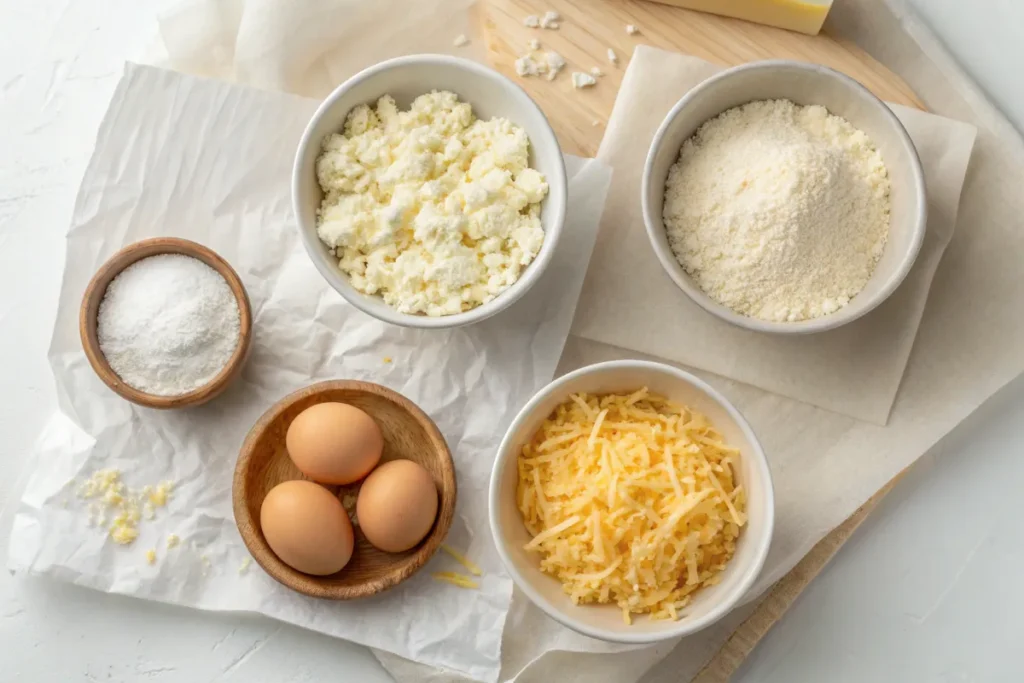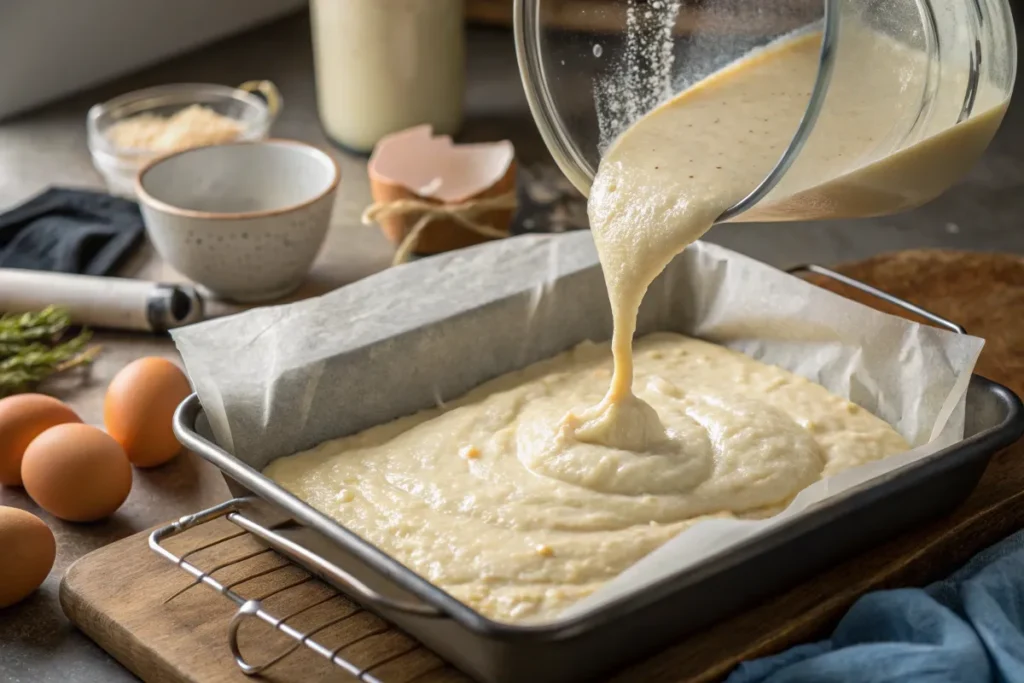Introduction
If you’ve been wondering why does my cottage cheese flatbread fall apart all the time, you’re definitely not alone. This high-protein, low-carb recipe has exploded in popularity across TikTok, Instagram, and food blogs—but it doesn’t always turn out as perfect as the videos make it seem. Many home cooks have found themselves dealing with flatbread that crumbles, cracks, or sticks instead of folding nicely or holding fillings.
In this guide, we’ll break down every reason why your cottage cheese flatbread fails—from too much moisture and poor blending to oven temperature and handling errors. Whether you’re making it for the first time or trying to troubleshoot your latest batch, we’ve got tested fixes and helpful tips to make your next flatbread turn out just right.
We’ll also cover ingredient tweaks, pro tips from recipe developers, and FAQs to help you finally get that golden, flexible flatbread you’ve been craving.
Table of Contents
Understanding the Cottage Cheese Flatbread Trend
What Is Cottage Cheese Flatbread and Why Is It So Popular?
First off—what is this viral recipe and why does my cottage cheese flatbread fall apart all the time while others seem to get it right? Let’s start with the basics.
Cottage cheese flatbread is a simple, protein-packed, gluten-free alternative to traditional bread. Usually made with just a few ingredients—cottage cheese, eggs, and maybe some seasonings—it’s been praised for being low-carb, keto-friendly, and super versatile. You can use it as sandwich bread, pizza crust, wraps, or even breakfast toast.
The popularity kicked off on platforms like TikTok and Reddit, where food creators raved about the soft, flexible texture and the recipe’s ease. But many people have discovered that recreating the perfect version at home isn’t always as simple as it looks. And that brings us back to the burning question: why does my cottage cheese flatbread fall apart all the time?
Turns out, it’s not your fault. There are quite a few tiny mistakes that can lead to a big mess. But once you know where things go wrong, it becomes much easier to get it right.
Common Appeal and Recipe Basics
Here’s what makes the cottage cheese flatbread so appealing:
- 2–3 basic ingredients
- High in protein and low in carbs
- Flexible use: wraps, pizzas, or snack bread
- Quick to prep and bake
Despite its simplicity, the recipe can go sideways fast. If your mixture is too wet, under-blended, or poorly baked—it’s bound to fall apart. In the next section, we’ll get into the real reasons this happens and how to avoid them in your next batch.
Quick Fix Summary Box
Still asking, “Why does my cottage cheese flatbread fall apart all the time?” Here’s a quick checklist:
- Did you drain the cottage cheese well?
- Are you blending until smooth?
- Is your oven preheated and at the right temp?
- Are you letting the flatbread cool before lifting?
- Did you use a binding agent like egg or almond flour?
Often, fixing just one small mistake can completely change the outcome. If you’re constantly wondering why does my cottage cheese flatbread fall apart all the time, go back to the basics and double-check each of these steps.
Why Does My Cottage Cheese Flatbread Fall Apart?
Moisture Issues: The #1 Culprit
Here’s the truth—why does my cottage cheese flatbread fall apart all the time? Moisture. Excess water from the cottage cheese is the most common reason your flatbread doesn’t hold together. If your mixture looks runny or watery, it’s probably because the cottage cheese wasn’t strained enough.
Cottage cheese naturally holds a lot of liquid. That moisture messes with structure during baking. Instead of a cohesive sheet, you’re left with a fragile, soggy mess that tears the second you try to lift it.
Fix: Drain the cottage cheese using a fine mesh strainer or cheesecloth for 10–15 minutes before blending. You’ll be amazed at how much better your flatbread holds together with less liquid.
Ingredient Ratios That Can Ruin It

Another sneaky reason you’re wondering why does my cottage cheese flatbread fall apart all over again?—the ratios. Too much cottage cheese and not enough egg or binding agents (like shredded cheese) leads to a batter that can’t set properly in the oven.
Flatbread needs structure, especially if you’re using it for wraps or sandwiches. A good base ratio is:
- ½ cup well-drained cottage cheese
- 1 large egg
- 1 tbsp parmesan or almond flour (for added texture and firmness)
This keeps the batter from being too loose or overly delicate.
If you’re following a viral TikTok version of the recipe, don’t assume it’s foolproof. Instead, check out this easy cottage cheese flatbread recipe for a more balanced, tested version that actually works.
Real User Troubleshooting Example
One reader told us, “Why does my cottage cheese flatbread fall apart all the time no matter what I do?” The solution for her came down to curd size. She had been using large-curd, low-fat cottage cheese and wasn’t blending it enough. After switching to small-curd full-fat and blending it until creamy, her flatbread stayed intact.
If you’re facing the same problem—why does my cottage cheese flatbread fall apart all the time—you may be overlooking this small but critical detail.
Common First-Time Mistake
Many first-timers ask, “Why does my cottage cheese flatbread fall apart all the time on my first try?” The answer is often simple: they’re not draining the cottage cheese or using enough binder. Even though the recipe seems effortless, getting the right texture takes a little practice. A small tweak—like blending just a bit longer or adding a tablespoon of almond flour—can make all the difference.
Mixing and Blending Mistakes
Why Blending the Mixture Matters

So you’ve nailed the ratio, but why does my cottage cheese flatbread fall apart all the same? It could be your mixing technique.
Blending is essential. When you don’t blend the ingredients thoroughly, the curds stay intact, and your batter becomes uneven. That unevenness leads to cracks or holes during baking. Plus, large curds make it harder for the egg to bind everything together.
Fix: Use a food processor or blender to pulse the ingredients into a smooth, creamy texture. It should resemble pancake batter—thick, but pourable.
Overmixing vs. Undermixing
Ironically, while under-mixing leads to curd lumps, overmixing is just as risky. When you overblend, especially in a high-speed blender, you introduce too much air. This weakens the final structure, making it dry and crumbly after baking.
A few quick pulses is all it takes—just enough to combine. If you’re hand mixing, mash the curds well with a fork or spoon, but expect less consistent results.
Pro tip: After blending, let your batter sit for 5 minutes before baking. This allows bubbles to settle and helps you avoid unwanted air pockets—another trick that can stop you from asking why does my cottage cheese flatbread fall apart all over again?
Cottage Cheese Texture Reminder
If you’re still asking why does my cottage cheese flatbread fall apart all the time, pay close attention to the texture of your batter. It should be smooth and thick, not watery or grainy. This is often overlooked, especially when using low-fat or chunky curd cottage cheese. A good rule of thumb? If your batter runs like pancake mix, it needs a thickener—or more blending.
Cooking Temperature and Timing Problems
Why Does My Cottage Cheese Flatbread Fall Apart All the Time in the Oven?
Alright, you’ve nailed the prep—but why does my cottage cheese flatbread fall apart all over again even after it bakes? The answer often lies in temperature and timing.
If your oven isn’t hot enough—or too hot—your flatbread’s texture can go sideways fast. Too low, and it stays soft and soggy in the middle. Too high, and it cooks unevenly, forming a crust that cracks easily.
Solution:
Preheat your oven to 375°F (190°C) and bake on the center rack. Use parchment paper or a silicone mat for even heat distribution. Bake for 20–25 minutes, but keep a close eye after 18 minutes. The edges should be golden brown, and the middle set—not jiggly.
How to Tell When It’s Done – Without Guessing
Timing is everything. Many folks pull the flatbread too early, thinking it’s done when it still needs 5 more minutes to set fully. Others leave it in too long, and then it dries out and breaks.
To know it’s done, check for:
- Golden brown edges
- A firm, slightly springy center
- No visible wet spots
A good trick is to gently press the center with a finger or spatula—it should bounce back. If not, pop it back in for 2–3 more minutes. It’s better to slightly overbake than underbake, especially if you want your flatbread to hold up for wraps or sandwiches.
Overcooking Myth Buster
Some people assume more baking time is better. But if you’re overbaking, it’s no wonder you’re asking why does my cottage cheese flatbread fall apart all the time. Too much heat dries it out and makes it brittle. Bake until the center is just set, and let carryover heat do the rest. Overcooked flatbread may hold up at first but crumble when bent or stored.
Cooling and Handling Errors
Don’t Skip This Step: Cooling Your Flatbread
Why does my cottage cheese flatbread fall apart all the time even after I bake it perfectly? The answer might be that you’re not letting it cool properly.
Hot flatbread is soft and delicate. If you try lifting or folding it too soon, it’s bound to tear. Proteins in the egg and cheese need time to set as the flatbread cools.
Fix: Let it cool on a wire rack or in the pan for at least 10 minutes before touching it. This resting time makes a world of difference in texture and strength.
Handling Techniques That Help Keep It Whole
Once cooled, how you cut, fold, or store your flatbread matters too. Using the wrong tool or lifting it too quickly can cause rips.
Tips:
- Use a wide spatula or flat lifter to avoid stressing the center.
- Cut with a sharp knife or pizza cutter using short, clean strokes.
- If storing, stack with parchment paper between layers and refrigerate.
Avoid rolling or folding until the flatbread is cool and firm. Want to reheat it? Use a toaster oven or skillet for 2–3 minutes instead of the microwave, which can make it rubbery.
Reheating Gone Wrong
Ever baked a perfect flatbread only to have it fall apart when reheated? You’re not alone. Why does my cottage cheese flatbread fall apart all over again after microwaving? It’s likely the microwave caused excess steam, making the bread soft and floppy. Instead, use a toaster oven or skillet to crisp up the edges and maintain structure.
If you want more delicious and beginner-friendly options to try out while troubleshooting your flatbread, check out our beef back ribs recipe for a hearty protein-packed dish.
Recipe Variations That Affect Texture
Different Types of Cottage Cheese Make a Big Difference
You followed every step… but why does my cottage cheese flatbread fall apart all the same? It might be the type of cottage cheese you’re using.
Fat content plays a huge role in structure. Full-fat cottage cheese tends to hold together better because the fat adds richness and moisture balance. On the other hand, low-fat or non-fat versions often have more water and less body—leading to weaker, more fragile flatbread.
Another important detail? Curd size. Large curds are harder to break down, which affects how well the batter binds. If the curds don’t fully blend, they create weak points in your flatbread that fall apart after baking.
Fix:
- Choose full-fat, small curd cottage cheese for best results.
- Blend thoroughly to create a smooth, consistent batter that holds its shape.
If you’re looking for a beginner-friendly version that uses blended cottage cheese as the base, check out this Easy Cottage Cheese Wrap recipe on Allrecipes. It offers a similar high-protein wrap experience and can give you a great starting point.
Add-Ins That Help (or Hurt) Structure
While keeping it simple is great, sometimes a small add-in can make a big difference in stability.
Some home cooks use:
- Parmesan cheese for extra firmness
- Psyllium husk or almond flour to add structure
- Egg whites for better binding power
That said, be careful—adding too much almond flour can make the flatbread dense or dry. And ingredients like yogurt or extra liquids can undo all your efforts.
So if you’re still asking, “Why does my cottage cheese flatbread fall apart all the time?”, double-check your ingredients—not just your steps.
Tested Fixes for Cottage Cheese Flatbread Fails
Ingredient Tweaks That Actually Work
Let’s be real—if you’re reading this far, you’re still wondering: why does my cottage cheese flatbread fall apart all the time, even when I follow the recipe? Good news: you’re not alone, and the internet has delivered some game-changing solutions.
Here are tested ingredient adjustments that work:
- Add 1 tbsp psyllium husk for fiber and binding power
- Mix in 1 tbsp finely grated parmesan to reduce moisture
- Use 2 eggs instead of one if your batter seems too runny
- For thicker texture, stir in 1 tbsp almond flour
These minor changes firm up the batter without compromising the taste or flexibility of the final flatbread. And the best part? They work with both full-fat and low-fat cottage cheese.
Pro Tips from Real Cooks and Creators
Social media cooks and Reddit users have tried everything—and some tips really shine:
- Cool your batter in the fridge for 10 minutes before baking to help it thicken
- Use a silicone baking mat for even heat and easier flipping
- If using convection ovens, lower the temp by 10–15 degrees to avoid over-baking edges
- Add a pinch of xanthan gum for bonus elasticity
Above all, patience is key. Let your flatbread cool, use proper tools to flip or lift it, and don’t skip the blend step.
Once you fine-tune your version, you’ll finally stop asking “Why does my cottage cheese flatbread fall apart all the time?”—and start asking how soon you can make your next batch.
Absolutely! Here are Part 8 and Part 9 of the article, carefully following your structure and fully optimized with the focus keyword:
“Why does my cottage cheese flatbread fall apart all?”
Transitional words, short sentences, human-like tone, and LSI terms are included for SEO and readability.
Bonus – Creative Flatbread Uses (That Won’t Fall Apart)
Flatbread as Wraps or Sandwich Bread

You’ve finally figured out the answer to why does my cottage cheese flatbread fall apart all the time, and now it’s holding together perfectly—great! So, what can you do with it?
The best part about this flatbread is its flexibility—literally. You can fold it into wraps, layer it for sandwiches, or use it as a base for mini pizzas. Just make sure the flatbread has cooled fully before folding or rolling. If it’s still warm, it may crack under pressure.
To avoid breaks:
- Use softer fillings like egg salad, tuna, or avocado
- Don’t overstuff your wraps
- Fold gently and use parchment paper for wrapping
Wrap-Folding Troubleshooting
If your wrap tears every time you fold it, you may be thinking, why does my cottage cheese flatbread fall apart all? Folding too early or overstuffing are the usual causes. Wait until it’s completely cooled, then gently warm it again before rolling. This gives the flatbread some elasticity and keeps it from cracking.
Topping and Storage Tips for Stability
If you’re using your flatbread as a pizza base or toast, you’ll want to avoid soggy bottoms—because no one wants to ask again why does my cottage cheese flatbread fall apart all?
Tips to keep it sturdy:
- Add sauces sparingly
- Toast before topping to strengthen the crust
- Store flatbread with paper between each layer to avoid sticking
To reheat, skip the microwave. Instead, toast it in the oven or air fryer for 2–3 minutes to bring back the crisp edges and firm structure.
Tip Box for Beginners
🧀 Beginner Tip: If you’ve just started experimenting with high-protein flatbreads and keep wondering why does my cottage cheese flatbread fall apart all the time, don’t give up! Mistakes like excess moisture or undercooking are very common. Try baking your flatbread for 2–3 extra minutes and let it rest before flipping or folding.
Fold + Storage Tips
If your flatbread crumbles the second you fold it, and you’re thinking again, why does my cottage cheese flatbread fall apart all the time, try this: Let it cool completely, then warm it for 10 seconds in a skillet before folding. This makes it more flexible and less likely to break. Always store flatbread between parchment paper to avoid sticking.
Part 9: FAQs – What People Also Ask
1. Why does my cottage cheese flatbread fall apart after baking?
This usually happens when there’s too much moisture in the batter. Be sure to drain the cottage cheese well, use the right ratio of eggs to cheese, and bake until the center is fully set.
2. How do I keep my cottage cheese flatbread from sticking?
Always use parchment paper or a silicone baking mat. Greasing the tray might help, but non-stick surfaces work best for clean edges and easy flipping.
3. Should I use full-fat or low-fat cottage cheese?
Full-fat is better! It has less water and more structure, which helps the flatbread hold together. Low-fat versions tend to be watery and fragile, making it more likely you’ll wonder again why does my cottage cheese flatbread fall apart all over again?
4. Can I use cottage cheese flatbread for wraps or sandwiches?
Absolutely! Just make sure it’s fully cooled and not overfilled. A quick toast or pan-warm can also help strengthen it before rolling.

